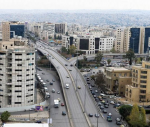You are here
Journalist discusses book documenting lives of ‘ordinary’ Jordanians
By Mustafa Ahmed - Feb 28,2019 - Last updated at Feb 28,2019
AMMAN — Jordanian journalist Rana Sweis on Wednesday discussed her latest book, “Voices of Jordan”, with an audience of around 40 people at the Sijal Institute of Arabic Language and Culture.
The purpose of the book, according to Sweis, was to tell “the story of Jordan through the lives of ordinary people”. She went on to say that it was important to show their perspectives, especially when discussing topics that her Western audience would be interested in reading about.
The author said that after organising focus groups comprised of New Yorkers wanting to know more about Jordan, she learned that topics such as women’s rights, education and the role of religion in society interested Western readers the most.
Sweis said that she was prompted to write the book after realising that books about Jordan were limited to “tourist guides, biographies about powerful people... and academic books on archaeology”.
According to Sweis, Jordan contains “the same social structural challenges the [entire] Middle East will have to deal with in the future” and that it was important to remember that “Jordan’s challenges have an ability to impact other parts of the world”. When asked what value the book provides to Jordanians, Sweis commented that “Jordanians don’t know enough about each other... We haven’t stopped to ask the big questions and as Jordanians we are not having these conversations”.
Sweis recalled one incident, in which bedouins from the north she was interviewing said that the gulf between rural and urban areas is so pronounced that people in Amman are sometimes unable to understand their accent.
“Voices of Jordan”, which took three years to complete, follows the lives of 10 ordinary Jordanians, who Sweis uses to explore the wider themes and topics affecting Jordan today.
According to the book itself, “the raw voices and everyday struggles of these people shine a fresh light on the politics, religion and society of a culture coming to terms with the harsh reality of modernisation and urbanisation at a time of regional upheaval”.
The 10 people Sweis observed — who she described as “mirrors of the Middle East” — came from different aspects of Jordanian society and from all parts of the country, and include figures as diverse as Salafist Naser Farhan, fashion designer Shirene Rifai and female MP Wafa Bani Mustafa. Sweis explained the book’s structure as “conversations taking place in different rooms of the same building”.
For Sweis, her background as a journalist — she covers political, social and refugee issues in the Middle East, most often for The New York Times — contributed to the narrative style of “Voices of Jordan”. When asked during the discussion whether her “overly-journalistic style” would benefit from a more “academic” approach, Sweis replied: “We are missing a way to tell stories that reach people... scholars aren’t reaching people.”
“Voices of Jordan” was published by Hurst Publishers in 2018 and features accompanying photographs taken by Jordan-based photographer Salah Malkawi.
Related Articles
Voices of JordanRana F. SweisLondon: Hurst and Co., 2018Pp.
AMMAN — Seven Circles, a consulting agency, and 360Moms, an online parenting website, launched a parenting book on Wednesday.The book, title
AMMAN — Last week, Jabal Amman Publishers launched the first virtual book fair in an attempt to make up for the missed book fairs schools no
















